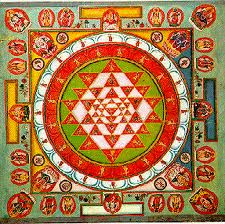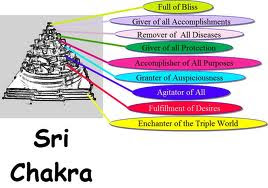The Sri Chakram, Sri Mahameru platform should always face East flat on ground. You should sit facing North and to the right of platform. The force of gravity of the northern direction will help you in your pooja. Likewise in the temple where the deity faces East. Coconut oil with cotton wick should be used for lighting lamp (Thiruvilakku Jothi). Ghee and gingerly oil can be mixed and used. Flowers without smell should not be used. It is not necessary to light incense sticks and camphor for pooja. You require only mantrams for pooja. Both Sri Chakram and Sri Mahameru possess same quality. It is the residing power of the great power that directs, protects, destroys their make and ceaselessly work. This chakram is based on our body only. The Sri Chakram Yantra was installed by Sri Athi Shankarar in many temples in Tamilnadu. You can take Sri Adi Sankarar as your Guru or whoever you think a guru who has the qualities. This form of worship leads our mind to gradually evolve into Para Psychological levels. Instead fixing our thought on a picture of image or a concept, our elders thought worshiping Sri Chakram is better. That is why, they place this chakram beneath the chief idol in the sanctum sanctorum of the temples. Only those who are endowed with purva punya will have inclination to worship Sri Chakram.
The worship of Devi in Sri Chakram is regarded as the highest form of the Devi worship. Originally Lord Shiva gave 64 Chakrams and their Mantrams to the world, to attain various spiritual and material benefits. For his consort Devi he gave the Sri Chakram and the highly coveted and the most powerful Shodashakshari mantram, which is the equivalent of all the other 64 put together.
Shiva along with Shakti is engaged in the eternal dissolution and recreation of the universe. The Bindu in the center of the Sri Chakram is the symbolic representation of the cosmic spiritual union of Shiva and Shakti. Apart from that the Sri Chakram also embodies countless number of deities and represents the whole of creation. Hence by worshipping the Devi in Sri Chakram one is actually worshipping the highest ultimate force in the Tantrik form.
Meru is a 3D object while Sr iChakram is a 2D rendering of the Meru!
The Meru is the three dimensions of the Sri Chakram. If we returned to the two dimension Sri Chakram, and imagine that the Bindu in its center is the peak of a mountain. The imagine that the mountain is built up in tiers, each tier being one of the circles of triangles or lotus petals, with the outermost square representing ground level. Now, imagine a vertical spine down the center of the mountain, then at each point that the spine and a tier intersect, there is a chakra. The peak represents Mount Meru, abode of the Gods.
The Basics of Sri Yantram:
Before starting the worship it is advisable to know about the way the Sri Yantram is constructed, what all it represents, about the 9 Avaranas, the deities, their gunas and significance, so that your worship is more meaningful. The following are the authentic details as given in various Tantra & Mantra scriptures.
Five downward pointing triangles representing Devi intersect with four upward pointing triangles representing Siva, forming 43 triangles including the central triangle..
From the five Shakti triangles comes creation and from the four Shiva triangles comes the dissolution. The union of five Shaktis and four Fires causes the chakra of creation to evolve.
At the centre of the Bindu of the Shri Yantram is Kamakala, which has three bindus. One is red, one is white and one is mixed. The red bindu is Kurukulla the Female form, the white bindu is Varahi the Male form, and the mixed bindu is the union of Shiva & Shakti – the individual as the potential Sri Chakram. Varahi, the father-form, gives four dhatus to the child and Kurukulla, the mother-form, gives five dhatus to the child. Theses represent the nine dhatus of the human body.
Varahi’s four fires are the 12 (4 x 3) sun Kalas, the 12 Zodiac constellations. Kurukulla’s five triangles are the 15 (5 x 3) Kalas of the moon, 15 lunar Tithis. These nine triangles also represent the nine stages of growth of the human child in the womb.
Surrounding the 43 triangles formed by the intersection of the nine triangles is the 16 petals circle. Surrounding the 16 petal circle is an 8 petal circle. After that the 3 lines and at the outermost part of the Sri Yantram there are 3 lines called the Bhupura. The 43 triangles constitute the six inner sections called Avaranas, the two circles of petals are two more avaranas and the Bhupura of 3 lines is the last Avarana.
These 9 Avaranas of the Sri Yantram have various presiding Devis. They are the Devi’s Parivar (retinue) of total 108. In the Sri Chakram pooja they are systematically worshipped one by one with their names and mantras. The presiding Deity of Srichakra, Devi, is Known as Lalita Tripura Sundari. The form of Devi Kamakshi of Kancheepuram is the closest resemblance of the Devi as described in the scriptures.
The Meru Chakra or Sri Chakra is a three-dimensional Sri Yantram, the embodiment of Sri Lakshmi (abundance) and Tripura Sundari (beauty). It is the yantra of Sri Vidya, sacred knowledge of the Goddess. It can also be seen as the unification of Masculine Divine and Feminine Divine: Shiva and Shakti, Lakshmi and Narayana, Purusha and Prakriti.
In Hindu devotional practice, three kinds of external symbols are used for worship of the Supreme Being, who is actually formless and nameless. The most external is that of divine images cast in human form, with paraphernalia symbolizing supra-human divinity.
The most subtle is that of the mantras or divine names with certain sounds. A mantra is divine power clothed in sound. Between these two come the yantrams or chakranjs , representing the deity in geometrical diagrams. Worshippers of Shakti consider the Sri Chakram the holiest and most significant of divine symbols.
The Sri Chakram is conceived as Shiva-Shakti in the macrocosmic as well as microcosmic aspects, as the cosmos and as the individual. The diagram consists of a series of nine triangles superimposed around a small central circle, Bindu, forming 43 konas or triangular projections. In the centre is the Bindu , representing Shiva-Shakti in union in the causal state from which all other parts of the diagram representing the cosmos are evolved.
The Bindu is in a central triangle with apex downwards – alternatively, it is below the base of the central triangle with its apex upwards, depending on whether it is a samhara-chakram or srishti-chakram. Enclosing it and super- imposed on one another are the four Shiva triangles with apex upwards and five Shakti triangles inclusive of the central one, with apex downwards. These are surrounded by two circles of lotuses, one with eight petals and the other, with 16. Outside these, there are three circles around and a rectangular enclosure of three lines for the whole figure, with four entrances on the four sides.
In the Bindu, Shakti i s represented as Maha-Tripura-Sundari, the great mother. The Bindu contains the potentiality of the universe within itself. It is spoken of as three to indicate the three stresses when the unified non-dual Shiva- Shakti becomes separated into the two aspects: prakasa, the aham or I-consciousness, and vimarsa, the idam or this-consciousness.
These three stresses are technically called Nada, Kala and Bindu. Bindu is the potential universe ready to separate into various categories. All these three stresses, mudras of Shiva-Shakti together, is represented by the central red line with an imaginary line across it to represent the polarity in that supreme category as Shiva-Shakti.
The Bindu , the creative Shakti , is the Mahatripurasundari , the ‘pride of Shiva’ or Shiva as prakasa – luminosity or consciousness – who realises Himself through Her, the vimarsa shakti.
The rest of the Sri Chakram represents the whole of the cosmos, Brahmananda , as evolved from the Bindu, standing for Tripurasundari or creative cosmic power… Just as Tripurasundari the Divine Mother is Shakti , depicted as the consort of Shiva, the Supreme Being, the Kundalini is the segment of that cosmic power as the Shakti of the Jiva, which is an amsa or particle of the Supreme Shiva embodied as the individual (microcosm). It is this Shakti that evolves in the individual the counterparts of all the 25 cosmic categories…
As the Supreme Will, Shakti is described as Consciousness-Bliss. The Saundarya Lahiri describes the universe in its subtle and gross forms as the trans- formation of Shakti. Though undergoing actual trans- formation into all these elements in their gross macro-cosmic aspect as the universe and in their subtle micro-cosmic aspect as the six chakrams in the body, Shakti is not lost in the effects – she retains her identity as the Supreme Will or Consciousness-Bliss.
Meru and Sri Chakra
There are nine chakras in the Sri Chakram. These nine Chakras have each a distinct form and a distinct name. Proceeding from the outermost to the inner, let us describe the Chakras.
The outermost is a square Chaturasra of three lines, the lines one inside the other,
opening out in the middle of each side as four portals. This is known as the Bhupura, the earth-stretch. This is the ground-plane if Sri Chakram is considered as graded elevations, Meru.
Through the portals in the Bhupura one enters the precincts. Immediately inside the square are three concentric circles which serve as three girdles trivalaya.
The space between the sides of the square and the circumference of the outermost circle, between Bhupura and Trivalya, is known as
1.Trailokya Mohana Chakra, the Enchanter of the Triple World.
Inside the 3 girdles are:
2. Sarvasa Paripuraka Chakra – 16 Petals – Fulfiller of all Desires;
3. Sarva Sanksobhana Chakra – 8 Petals – Agitator of all;
4. Sarva Saubhagyadayaka Chakra – 14 Triangles [Chaturdasa Kona] – Giver of all Auspiciousness;
5. Sarvartha Sadhaka Chakra – 10 Triangles [Outer Dasara] – Accomplisher of all Purposes;
6. Sarva Raksakara Chakra – 10 Triangles [Inner Dasara] – Giver of all Protection;
7. Sarva Rogahara Chakra – 8 Triangles [Ashta Kona] – Remover of all Diseases;
8. Sarva Siddhiprada Chakra – Inverted Primary Triangle – Giver of all accomplishments and
9. Sarvanandamaya Chakra – Bindu – Full of all Bliss.
2D Srichakra Yantra
1st Avarana the outer square with three lines and 4 gates is brown. The outer line is white (though the colour of the 10 deities here is like molten gold), the middle line is orange red like the rising sun and the inner line is yellow like the colour of butter.
2nd Avarana the 16 petal lotus is pink like lotus flower.
3rd Avarana the 8 petal lotus is red – the colour of Bandhuka flowers.
4th Avarana the 14 cornered triangle is colour green like the colour of glow worms.
5th Avarana the outer 10 corners triangle is red like Japakusuma flowers.
6th Avarana the inner 10 corners triangle is colour blue (though the deities here have the lusture of 1000 rising suns).
7th Avarana the 8 corners triangle is colour red like Dadini flowers.
8.The innermosst triangle is white.
9.The Bindu the central point is red like Sindoor.
Tripurasundari Maha Mantra: “Om Aim Klim Saum”
Sri Chakram is the most calm, harmless, genteel and non aggressive of all the yantrams. In fact a Sri Chakram is helpful where there are fierce elements disturbing the peace or creating bad effects, in order to reduce the effect.
One should approach the Divine Mother without any reservations. One need not express one’s want, difficulties, complaints, problems to her for she knows your needs better and will give you what you need and at the same time she will also protects you.

